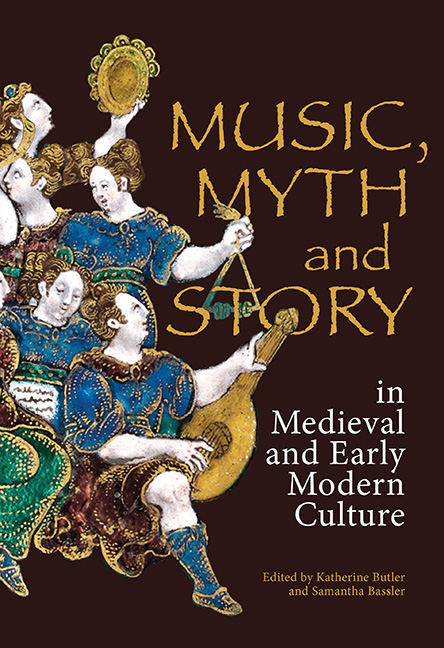Book contents
- Frontmatter
- Contents
- List of Illustrations
- List of Contributors
- Editors’ Note
- Introduction
- I MYTH IN MEDIEVAL MUSIC THEORY AND PHILOSOPHY
- II ICONOLOGIES OF MUSIC AND MYTH
- 4 The Harmonious Blacksmith, Lady Music and Minerva: The Iconography of Secular Song in the Late Middle Ages
- 5 Foolish Midas: Representing Musical Judgement and Moral Judgement in Italy c.1520
- III MYTHS IN RENAISSANCE PHILOSOPHIES OF MUSIC
- IV MYTH AND MUSICAL PRACTICE
- V NARRATIVES OF PERFORMANCE
- VI MYTH AND MUSIC AS FORMS OF KNOWLEDGE
- VII RE-IMAGINING MYTHS AND STORIES FOR THE STAGE
- Bibliography
- Index
- Studies in Medieval and Renaissance Music
4 - The Harmonious Blacksmith, Lady Music and Minerva: The Iconography of Secular Song in the Late Middle Ages
from II - ICONOLOGIES OF MUSIC AND MYTH
Published online by Cambridge University Press: 24 October 2019
- Frontmatter
- Contents
- List of Illustrations
- List of Contributors
- Editors’ Note
- Introduction
- I MYTH IN MEDIEVAL MUSIC THEORY AND PHILOSOPHY
- II ICONOLOGIES OF MUSIC AND MYTH
- 4 The Harmonious Blacksmith, Lady Music and Minerva: The Iconography of Secular Song in the Late Middle Ages
- 5 Foolish Midas: Representing Musical Judgement and Moral Judgement in Italy c.1520
- III MYTHS IN RENAISSANCE PHILOSOPHIES OF MUSIC
- IV MYTH AND MUSICAL PRACTICE
- V NARRATIVES OF PERFORMANCE
- VI MYTH AND MUSIC AS FORMS OF KNOWLEDGE
- VII RE-IMAGINING MYTHS AND STORIES FOR THE STAGE
- Bibliography
- Index
- Studies in Medieval and Renaissance Music
Summary
TOWARDS the end of Imperial Rome's dominion of North Africa, Martianus Capella penned his encyclopedic De nuptiis Philologiae et Mercurii (‘On the Marriage of Philology and Mercury’). The spectacle of Harmony's entrance in the last book surpasses that of all other Liberal Arts. A train of minor deities, three musically inclined demigods (Pan, Silvanus and Faunus) and three legendary musicians (Orpheus, Amphion and Arion) precede her. Harmony enters, clad in gold, flanked by Phoebus Apollo and Minerva, and trailed by her mother Venus. She carries a shield decorated with concentric circles, attuned to one another and pouring forth a concord of all the modes. Her shield symbolises celestial harmony or the harmony of the spheres. Finishing a paean to the gods, Harmony complains that she has been forbidden to give an exposition of her art even among the stars when the heavens produce a harmony concordant with ‘the gamut of all proportions’. Yet, she goes on, she is the twin sister of the heavens, the shaper of human intelligence and character, and used by the Pythagoreans to assuage men's ferocity. She invented musical instruments for humanity, was responsible for the song by which men praised the gods, and placated the underworld deities through ‘mournful song’. Her songs were used for military purposes, in times of peace, and – in a reference to Orphic lore – even to bend animals to human will. All mundane natural and manufactured things mirror the same celestial order that is Harmony, and Harmony is responsible for placating the gods and moving both humans and animals.
Martianus's De nuptiis exercised a profound influence directly and indirectly on subsequent authors and traditions. The author's vision of Harmony as a formidable young woman would be transformed iconographically into her equivalent, Musica (or Lady Music), in the following ages. To distinguish the more general understanding of music prevalent today from that of Antiquity, the Middle Ages and even the early modern period, I will use musica to refer to the often cosmologically bound idea of music in the Middle Ages and Musica for its allegorical representation.
The two allegories – one literary, the other pictorial – that frame this essay encompass the rich mythical iconography of music in the late Middle Ages and early Renaissance.
- Type
- Chapter
- Information
- Publisher: Boydell & BrewerPrint publication year: 2019



